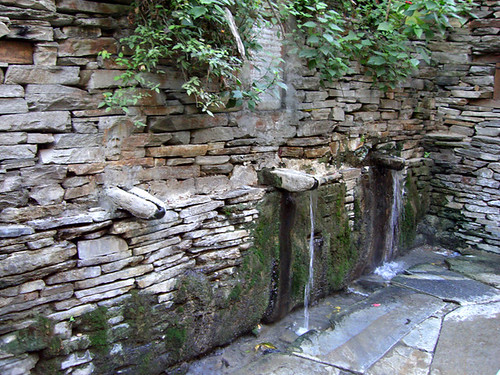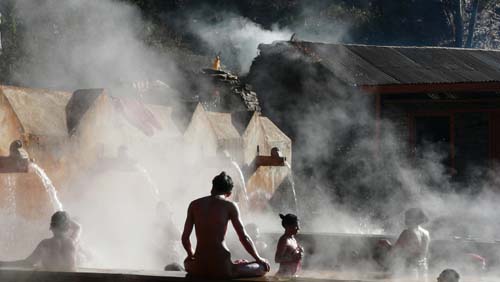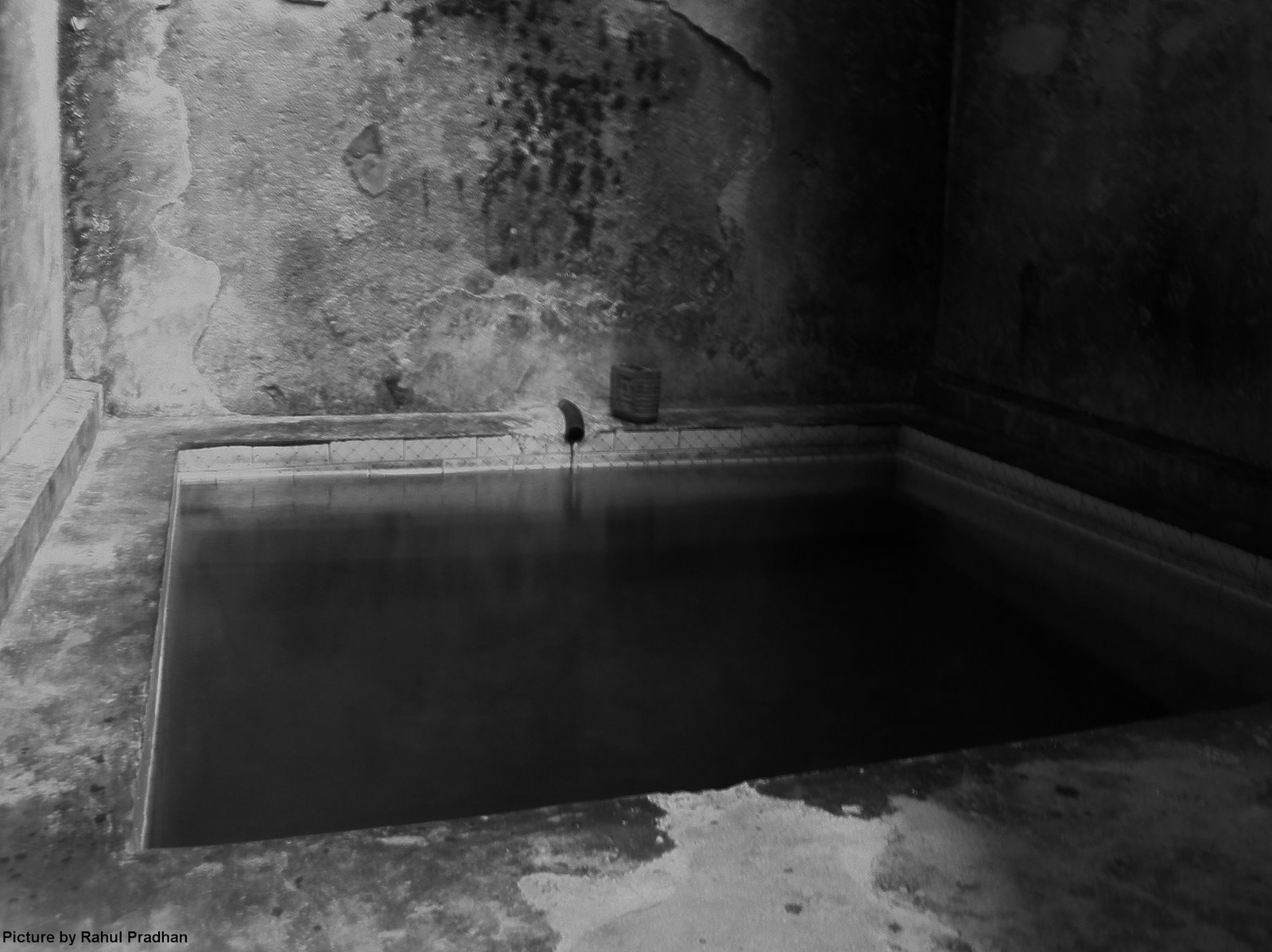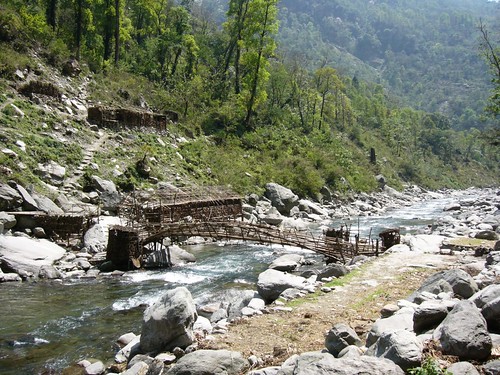Introduction
As elsewhere in Nepal, hot springs mostly follow the deeper valley streams and the Kali Gandaki river which flows between the Dhaulagiri and Annapurna mountain rangess is no exception. The other hot springs in this area are near the Modi Khola and Myagdi Khola rivers. This area is quite accessible and thus sees many (foreign) visitors which together leads to many links and stories on internet.
Though I have seen Kodari mentioned as the number 1 place in Nepal for soaking, the Tatopani (Tatopani means just hot water in Nepali) is located along the Kali Gandaki and until recently was the last place visited on many of the local treks [2013: road has extended beyond Tatopani]. However it's popularity and thus it's possible status as Nepal's no. 1 soak spot is increasingly being challenged by the much smaller but possibly more pleasant Jhinu.
Elsewhere in the same region, along the Myagdi Khola are a number of hot springs which see many Nepali tourists and hardly any foreigners.
Upper reaches of the Kali Gandaki
Starting the list from the upstream downwards the first hot spring mentioned is Dhima in Mustang (district, formerly a local kingdom) which a few (repetitious) web sites mention as having a hot spring.
Another Mustang town with a hot spring is Jomsom. Smack bang on the tourist route, Jomsom has been mentioned as having hot springs, though the soak sites seem pretty much undiscovered out there on the net.
The Tatopani
Located at the end (or beginning) of two of Nepal's most popular treks, Tatopani receives it's fair share of wearied trekkers who use the sizeable town to put their feet up, eat apple pie and soak.
Though officially known as Bhurung Tatopani, the town has become synonymous with the Nepalese term for hot springs Tatopani. Info on this place is extensive, google gives just under 6,000 hits for this site on blog search only! A recent blog posting:
Onsensoakers' Facebook page mentions from a very recent visit a second hot spring at Tatopani, probably located on the other bank of the river:
Not far south of Tatopani is Ratopani, which by the looks of this Japanese language website photo is another great place to soak. Unfortunately not much more info. It should be located on the other side of the Kali Gandaki river. A posting on the LP forum mentions Ratopani briefly. Another poster in the same referring to Tatopani:
Onsensoakers' Facebook page has recently put up some more info:
Then there are mentions made of hot springs in Dova, the administrative area south of Tatopani which probably is the same hot spring of Do Khola. Dana might also have a hot spring, it is at least listed as such.
Elsewhere in Myagdi'A number of hot spring are found in the hillside on the west of the village Jomsom'.Could the following be the source of preceding:
'On the west bank of the Kali Gandaki river, at the foot of a hillock, are other hot springs. Spring water flows at thirty liters per second here'.
Located at the end (or beginning) of two of Nepal's most popular treks, Tatopani receives it's fair share of wearied trekkers who use the sizeable town to put their feet up, eat apple pie and soak.
Though officially known as Bhurung Tatopani, the town has become synonymous with the Nepalese term for hot springs Tatopani. Info on this place is extensive, google gives just under 6,000 hits for this site on blog search only! A recent blog posting:
'On top of all that, any trekker reaching Tatopani (in Nepali, 'hot waters') in the course of the Annapurna Circuit will experience one of the most pleasant sensations of his life: bathing in a hot spring. Oh my! that was good, yes, it felt good! I spent almost 4 hours in the 50ish degree hot water, listening to music and chatting with fellow trekkers (who by now had become some sort of nomad family)'.Unfortunately due to the road extending from Beni (Myagdi district capital) and beyond to the north this may well result in a change of soaking scene. Then again it's fame might simply attract more ...
Onsensoakers' Facebook page mentions from a very recent visit a second hot spring at Tatopani, probably located on the other bank of the river:
'I hadn't known there were two soaking spots @ TATOPANI before visiting there, so I was happy to find this rather primitive mixed bath. Admission 50Rs (US$0.5). I heard most soakers came here to cure their disease'.
Not far south of Tatopani is Ratopani, which by the looks of this Japanese language website photo is another great place to soak. Unfortunately not much more info. It should be located on the other side of the Kali Gandaki river. A posting on the LP forum mentions Ratopani briefly. Another poster in the same referring to Tatopani:
'In my opinions, [Tatopani is] not very nice. Now located next to the awful dirt road. It was very nice in 1983 when I visited first'.Everything used to better in the past, except life expectancy ...
Onsensoakers' Facebook page has recently put up some more info:
'Men's soaking time just started. Lonely Planet and trekking maps don't cover this hot springs, and it was so difficult to make the bus conductor and other passengers understand I want to get off here, not TATOPANI. I had to yell for stop so many times to get off here. After soak, I walked easy but dusty 3km to TATOPANI
...
RATOPANI @ end of ladies time - men and ladies share this soaking pond every two hours in turn. They welcomed me and asked to take picture of them. left bath was rather hot at 45℃, center at 42℃. non-commercial'.
Then there are mentions made of hot springs in Dova, the administrative area south of Tatopani which probably is the same hot spring of Do Khola. Dana might also have a hot spring, it is at least listed as such.
Myagdi district is gifted with quite a few soaks. Heading west from the district capital of Beni one arrives at Singha (Singa) Tatopani.
I myself have visited here but that was more than 15 years ago. Located next to the river it has since been washed out and renewed. At that time I was quite surprised at the amount of local visitors; the nearby bazaar and village thriving on the visitors expenditure. The Myagdi District Center of Commerce and industry describes it as:
Furthermore of recently it has it's own Facebook page, it looks as though the improvements have been the building of a roof. It seems a bit strange to build a roof, maybe someone can give me a hint?
I myself have visited here but that was more than 15 years ago. Located next to the river it has since been washed out and renewed. At that time I was quite surprised at the amount of local visitors; the nearby bazaar and village thriving on the visitors expenditure. The Myagdi District Center of Commerce and industry describes it as:
'The Singa Tatopani Pond is used for treatment of varies diseases like gastrotrich, Skin disease etc. Thousands peoples in a year come to take bath from far distance too. Those hot spring ponds are tourism-attracting spot itself for relax and used for treatment too. Therefore, it could be developed health tourism resource also'.If thousands already visit, is it not a tourist attraction? It has also been described at a congress on geothermal issues.
Furthermore of recently it has it's own Facebook page, it looks as though the improvements have been the building of a roof. It seems a bit strange to build a roof, maybe someone can give me a hint?
From the Singha Tatopani Facebook page: a packed hot spring.
Other Myagdi district hot springs included on lists but to which little or no more can be added are Dagnam, Dhadkharka, Mudi and Dova, all located or referred to in their own Village District Committee administrative borders.
Jhinu
Lying in the shadow of the Annapurna's and along the Modi Khola river lies the hot spring of Jhinu. Though located along a much frequented trekking route (near Chomrong enroute to the Annapurna Base Camp) it seems to evade many. It's only located a 20 minute drop from the village, not always conducive to a soak because one needs to return back up the hill...
Some experiences of soaking in Jhinu from Dan Keezer:
Jhinu Danda hot spring. From flickr member Mike Olszewski
Some experiences of soaking in Jhinu from Dan Keezer:
'The hot springs were nice but crowded. They had some pipes for showers, however, which was really great (HOT SHOWER!)'.Ek, do, tin, achaar:
'Around 9pm, we went down to the hot spring, about a 20 minute walk. It was pitch dark and through a narrow stone path down into the forest, which was amazing. We heard the river getting louder and it was flowing at a rapid pace. The hot springs were just next to the river, in a cut-out and rock-layered pool of 4 by 6 meters, made by locals. Wow, they were so cosily warm, as if it was nature massaging your limbs and body. We had brought candles for light and it only added more to the special atmosphere. Many shadows flickered on the rocks while the sky above us was filled with stars, so many! We just felt lucky to experience this unspoilt place, especially at the time of the darkened day. The walk up, well, that was a bit harder again after this softening experience. Exhausting we went to bed.zzzzz'.In an oddly titled blog entry, 'Jap Quality Hotspring in Jhinu' (I believe it's a compliment), Sandy writes :
'Yet, after 20 minutes of walk from the lodge, I got to the hot spring and I was impressed. It’s clean and well maintained, similar to those in Japan. But instead of stripping naked, please cover up and put on a pair of shorts at least (and a tee or swimsuit for the ladies). While it is okay for men to be topless in the hot spring nowadays, apparently, naked or topless appearance in public places in Nepal is considered offensive'.Jhinu hot spring surely looks great, I have even seen mentions made of cooling off in the adjacent Modi Khola river, though that water is most probably frigid. Beware though during the rainy season, the Annapurna region becomes one waterfall and the hot springs are inundated. See (and read) Eric Lon's photo below:
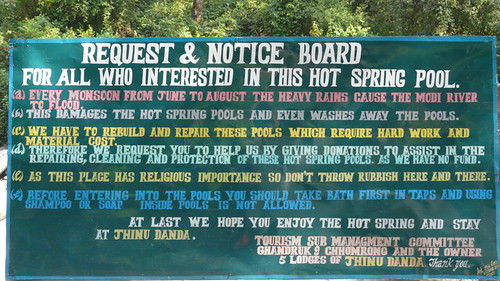
Disturbing
Finally, along the Seti river in Kaski district near Kharpani is another hot spring. It is part of the so-called Sikles trek, though again not much detail is on offer. Luckily the Gorkhapatra (back in 2008) has a full feature on Kharpani and the attraction of it's hot springs:
'There is a small wonder of nature at Kharpani, Kaski, which lies about 20 km away from Pokhara. Three ponds of hot water on the bank of Seti River attract one and all. It is widely believed that water in those three ponds do have medicinal value. After having taken bath in these ponds, many people have been cured from several physical ailments, say many people. A hot water pond in the icy waters itself startles many. ...Hari Bahadur Sunar, an octogenarian local of Sardikhola VDC told some breathtaking stories about the hot water ponds. "I was a small boy then when my father told me this story. A man from nearby village was regularly visiting to this site where now we can see the ponds. The man was chopping off the tree into small pieces so that he could carry them off easily in small bundles. For this purpose he was visiting the site for several days. During the interval of chopping wood, he noticed that a crow with one of its dangling legs was regularly visiting the site. Out of curiosity, he started watching the activities of the bird. He saw the bird was regularly taking a plunge into a certain place in the river. The bird repeated the act almost every day. Then one day the woodcutter was much surprised when he saw the bird’s dangling leg was completely healed and it was firmly standing on its both of legs". ...When this scribe met a few ladies in the next pond they looked rather tinged with anger. Sita Gurung from Phulbari, said: "The place is completely mismanaged. The ponds are small and uncomfortable. A little effort is enough to expand the sizes of ponds, which the management has neglected. Our main complain is that at least one pond should be reserved for ladies alone. We feel very uncomfortable to share the same pond with men. And some try to take benefit of the situation".
Meanwhile yet another lady popped out her head from the water and said: "You can also see some people using soap on their bodies and wash it off into the pond. This is disgusting indeed. This is the gross negligence on the part of the management committee. When they take money from us they are morally bound to provide us facilities we require. A small bathroom or two should immediately be constructed so that after a dip in the hot pond, we could wash off our body with the fresh river water"'.
Arunlimbu has [had] some photo's from 2007. Then this is possibly a more recent picture (below). But that pre-dates 2012 ...
'Tatopani hotspring in Kaski, Nepal. Photos: Raj'
Also known as Sardi Khola, Kaski, the Himalayan Times (4-3-2011) has this photo with caption:
'Local women taking a dip in the hot springs at Tatopani Kunda in SardiKhola‚ Kaski on Sunday‚ April 3‚ 2011. The hot springs are believed to have a healing effect on ailments including constipation‚ joint pains and skin diseases'.
Note that since these hot springs have disappeared. Tragically this happened with a massive mudslide which hit non-suspecting soakers in 2012 as well as other villages and towns along the river. The Nepali Times (#654, May 2013):
'It was Saturday morning of 5 May last year and many picnickers from Pokhara had come to the hot springs at Sardi Khola for a dip. Chahana Pun, 13, her family, and neighbours were also by the riverside.This little reported tragedy ended the lives of no less than 63 persons. Noguchi-ken has an extensive photo reportage shortly after the tragic events in Japanese. If seeking more info, beware of some extremely disturbing pictures and video's of this freak event.
Suddenly there was a roar from the north, the Seti River had turned into a brown wall of mud, boulders, and tree trunks. Chahana’s parents and baby brother were washed away and only she and her elder brother Amrit survived'.
The hot springs have since disappeared.
Quandry
Finally back to Tatopani. Nepal is a rather conservative society no more so when bathing in public. Though it is common to see women showering half-naked in more remoter areas where the new conservatism has not triumphed over practicality, Tatopani is not the place to adhere to back to the nature soaking. Allie in her blog entry on Tatopani is mystified:
[Updated June 2013]
Finally back to Tatopani. Nepal is a rather conservative society no more so when bathing in public. Though it is common to see women showering half-naked in more remoter areas where the new conservatism has not triumphed over practicality, Tatopani is not the place to adhere to back to the nature soaking. Allie in her blog entry on Tatopani is mystified:
'And now I face a quandary – how much clothing to keep on [while soaking in Tatopani]? Nepalis are very modest; we haven’t seen couples kiss or even hold hands in public, and most women dress with shoulders and knees covered. Stripping down to my bikini seems immodest – appropriate in Turkey, but not here.Difficult, just lucky that as a male I have less problems with dress-code ...
In one pool an Italian woman wears a swim ensemble of black ribbons tied together for strategic coverage. She’s getting a lot of attention from the local guys, but seems clueless. Most foreigner women are in one-piece suits and a few wear shirts over their suits. I look for Nepali women to provide some cultural guidance, but there are none. So I go halfway – I keep a long black shirt on over my bikini, but take off my shorts. The water is hot, and it feels AMAZING to soak our bodies after two weeks of bucket washes and cold showers.
As dusk turned to dark, most foreigners leave the pools. We buy a Sprite from the snack shack and settle in. When it is dark, a new group arrives at the pools: a group of young Nepali women. And what do they wear? Tank tops, t-shirts AND shorts! Ah, everything is relative – a half hour earlier I felt slightly prudish in my ensemble, and now I feel half-naked, which compared to these Nepalis, I am'.
[Updated June 2013]











